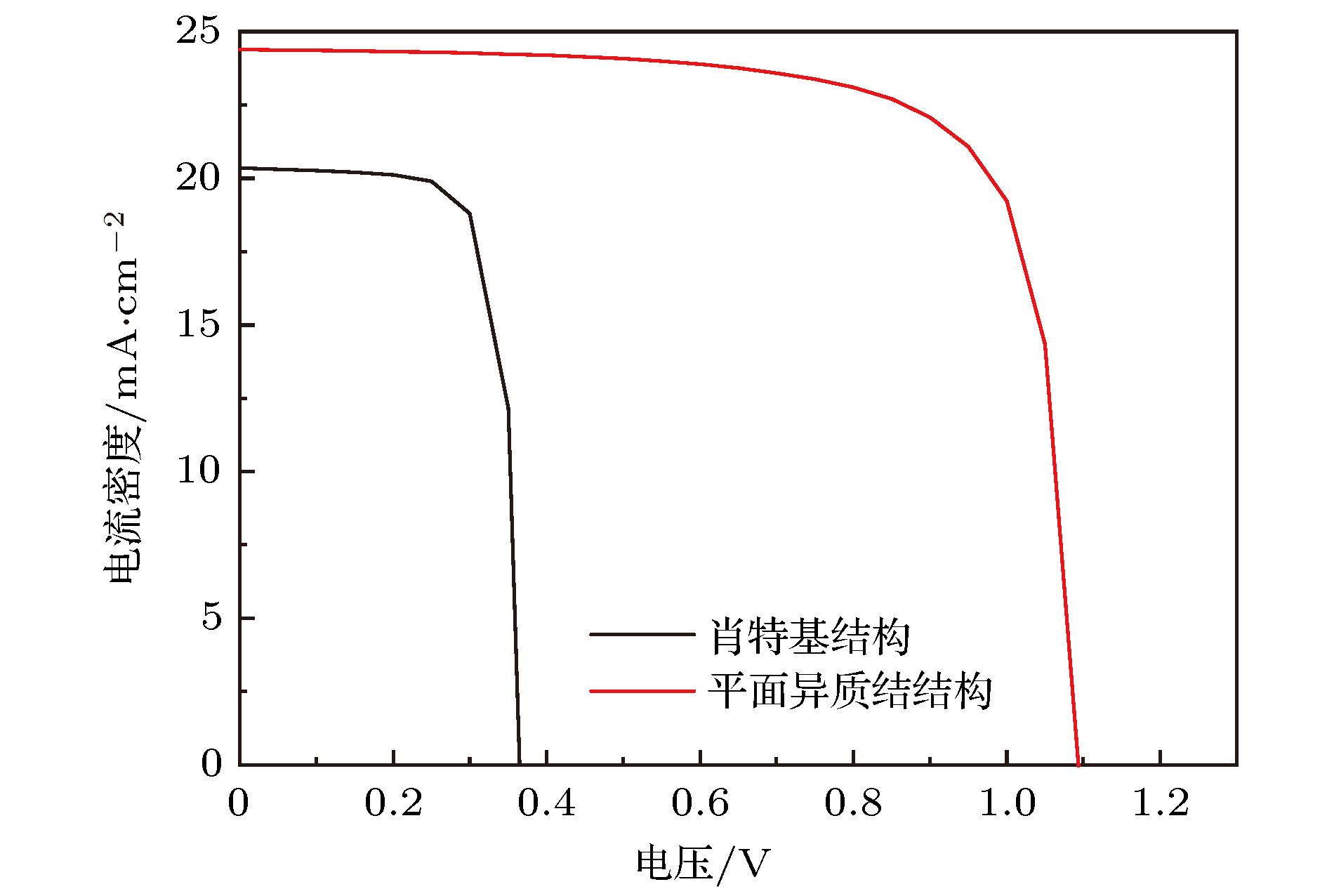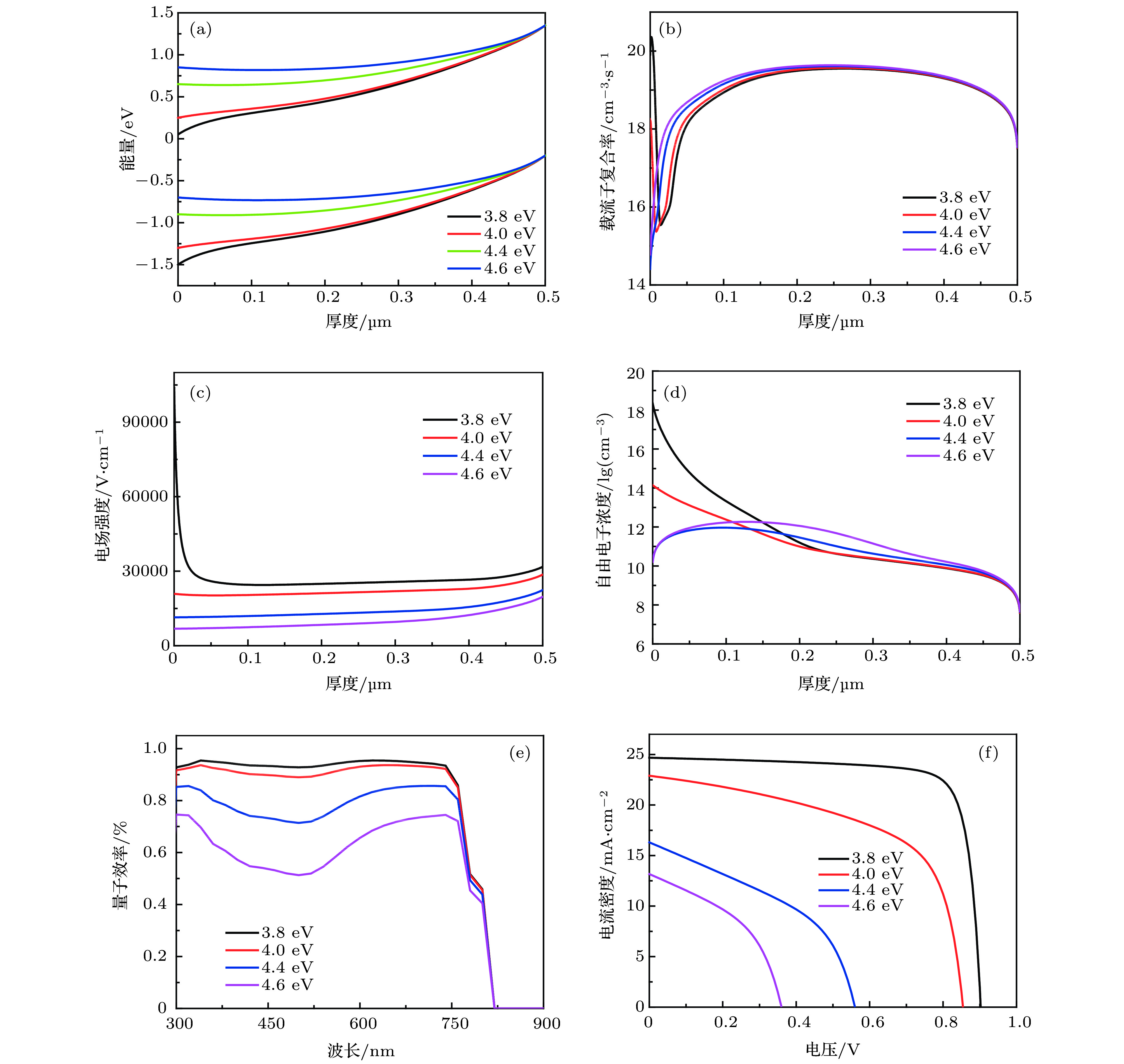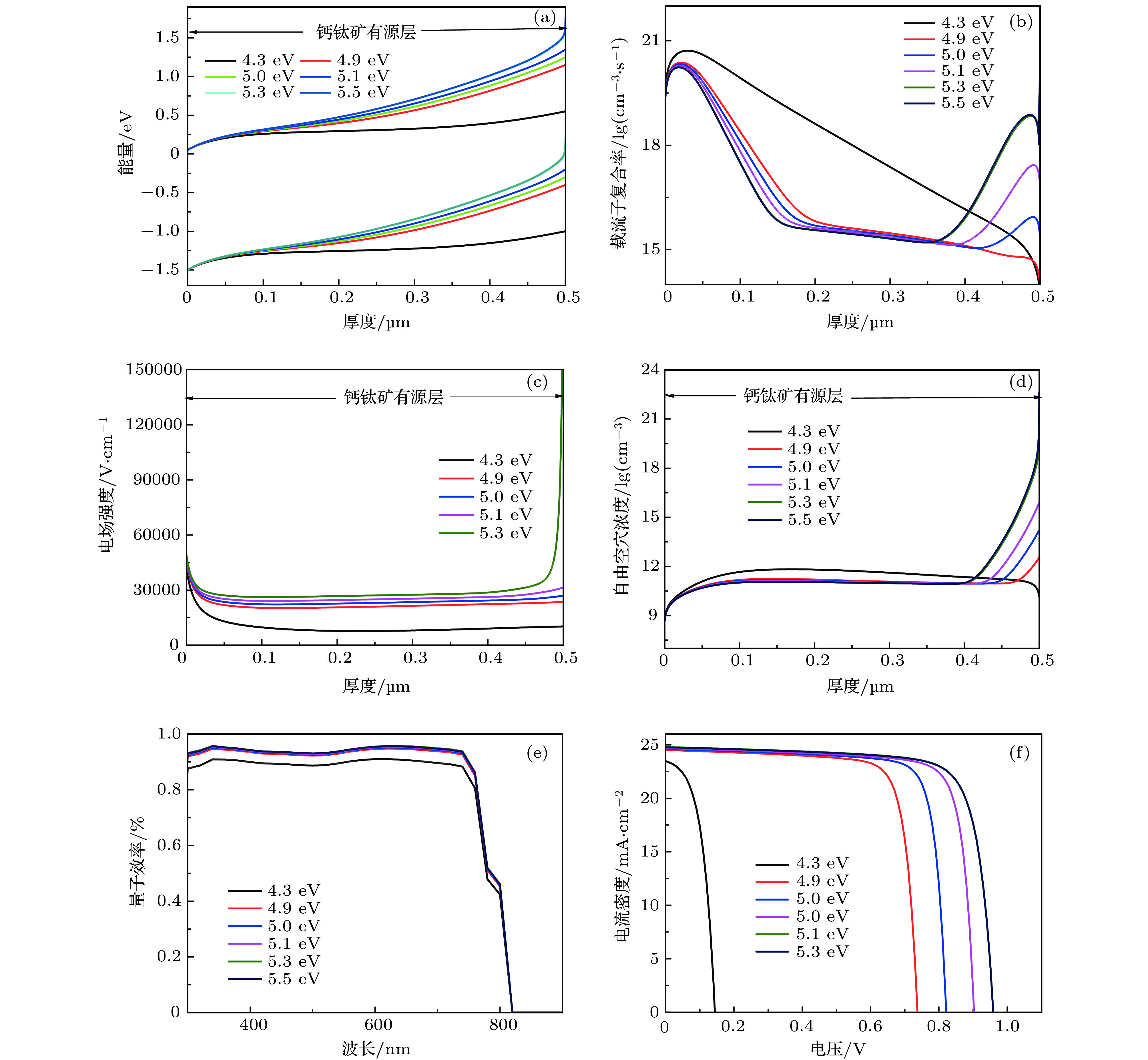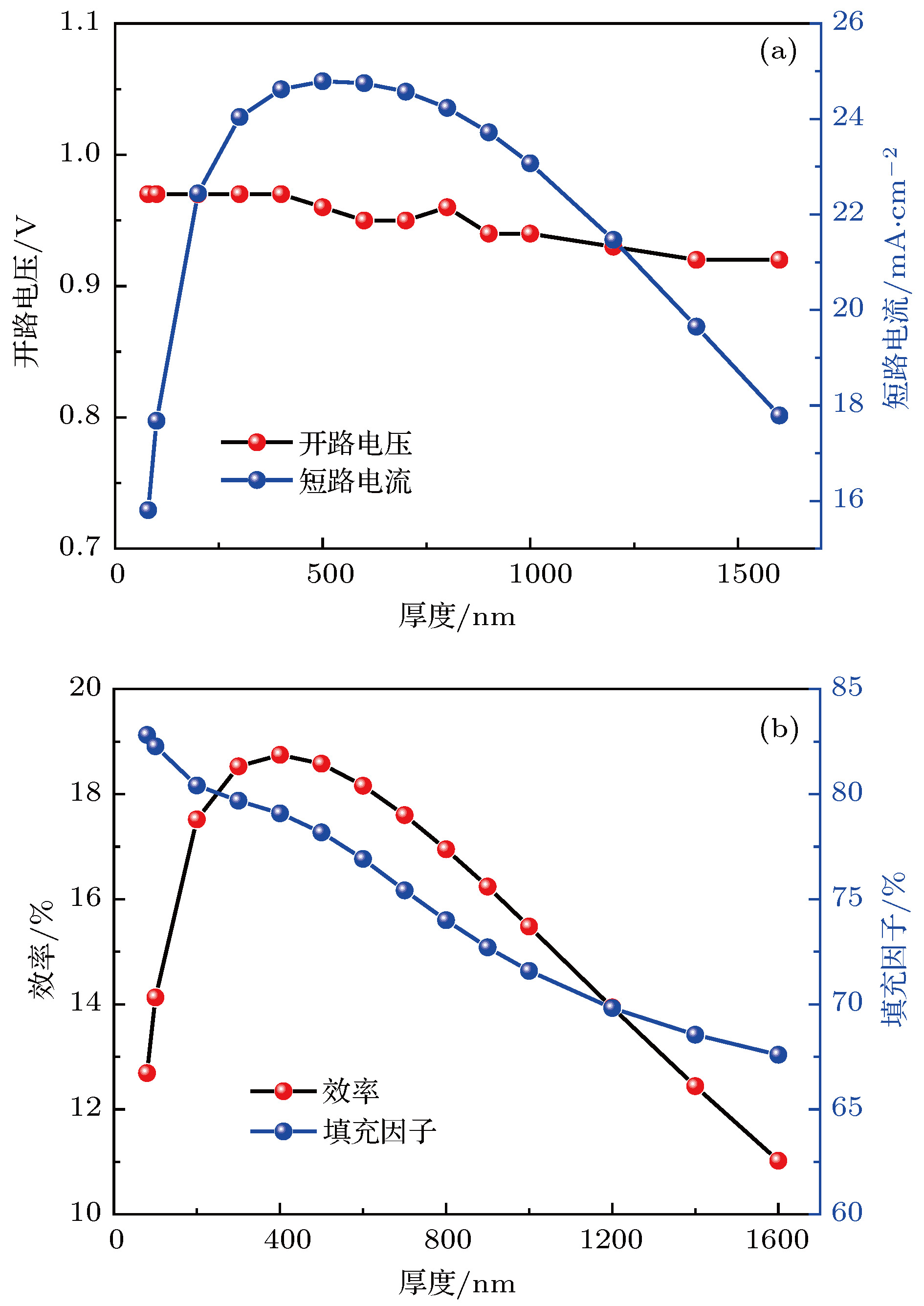-
The wx-AMPS simulation software is used to model and simulate the Schottky perovskite thin film solar cells. The front and back electrodes with different work functions are applied to the Schottky perovskite solar cells to study the effect of band structure on the performance of solar cells. The results show that in a range from 3.8 to 4.4 eV, as the work function of the front electrode decreases, the conversion efficiency of the Schottky solar cells gradually increases. When the work function of the front electrode is low, the electric field strength is large, which facilitates the transport of carriers in the light-absorbing layer of the perovskite and reduces the carrier recombination rate of the perovskite layer. In addition, the recombination ratio of the light absorbing layer is reduced due to the increase of the electric field strength, and the parallel resistance is increased to a certain extent thereby increasing the FF and improving the output efficiency of the battery. At the same time, when the current electrode work function is maintained at 3.8 eV, in a range from 4.3 to 5.5 eV, the higher the work function of the back electrode, the greater the conversion efficiency of the Schottky solar cell is. This conduces to the band alignment in contact between perovskite and back electrode. Under the premise that the common electrode Au is used as a back electrode, the work function of the front electrode is 3.8 eV and the conversion efficiency of the Schottky perovskite solar cell is 17.93%. In addition, by using the optimized front and rear contact electrodes, the quality of the perovskite layer material, thus the performance of the solar cell can be further improved. Doping till a certain concentration and removing the defects of the perovskite layer, the conversion efficiency of the solar cell with a thickness of 500 nm can be increased from 17.93% to 20.1%. The simulation results show that the Schottky perovskite thin film solar cells can obtain excellent performance with simple device structure and have great potential applications.
-
Keywords:
- Schottky solar cell /
- wx-AMPS /
- carrier transport layer /
- perovskite solar cell
[1] Kojima A, Teshima K, Shirai Y, Miyasaka T 2009 J. Am. Chem. Soc. 131 6050
 Google Scholar
Google Scholar
[2] Im J H, Lee C R, Lee J W, Park S W, Park N G 2011 Nanoscale 3 4088
 Google Scholar
Google Scholar
[3] Hodes G 2013 Science 342 317
 Google Scholar
Google Scholar
[4] Mei A Y, Li X, Liu L F, Ku Z L, Liu T F, Rong Y G, Xu M, Hu M, Chen J Z, Yang Y, Gratzel M, Han H W 2014 Science 345 295
 Google Scholar
Google Scholar
[5] Jeon N J, Noh J H, Yang W S, Kim Y C, Ryu S, Seo J, Seok S I 2015 Nature 517 476
 Google Scholar
Google Scholar
[6] Sun X, Zhang C F, Chang J J, Yang H F, Xi H, Lu G, Chen D Z, Lin Z H, Lu X L, Zhang J C, Hao Y 2016 Nano Energy 28 417
 Google Scholar
Google Scholar
[7] Yang W S, Park B W, Jung E H, Jeon N J, Kim Y C, Lee D U, Shin S S, Seo J, Kim E K, Noh J H, Seok S I 2017 Science 356 1376
 Google Scholar
Google Scholar
[8] Best Research-Cell Efficiencies. https://www.nrel.gov/pv/assets/pdfs/best-research-cell-efficiencies.20200104.pdf
[9] Zhang P, Wu J, Zhang T, Wang Y F, Liu D T, Chen H, Ji L, Liu C H, Ahmad W, Chen Z D, Li S B 2018 Adv. Mater. 30 1703737
 Google Scholar
Google Scholar
[10] Zuo C T, Bolink H J, Han H W, Huang J S, Cahen D, Ding L M 2016 Adv. Sci. 3 1500324
 Google Scholar
Google Scholar
[11] 丁雄傑, 倪露, 马圣博, 马英壮, 肖立新, 陈志坚 2015 物理学报 64 038802
 Google Scholar
Google Scholar
Ding X J, Ni L, Ma S B, Ma Y Z, Xiao L X, Chen Z J 2015 Acta Phys. Sin. 64 038802
 Google Scholar
Google Scholar
[12] Chen Z, Wang J J, Ren YH, Yu C L, Shum K 2012 Appl. Phys. Lett. 101 093901
 Google Scholar
Google Scholar
[13] Piliego C, Protesescu L, Bisri S Z, Kovalenko M V, Loi M A 2013 Energy Environ. Sci. 6 3054
 Google Scholar
Google Scholar
[14] Yang S J, Kim M, Ko H, Sin D H, Sung J H, Mun J, Rho J, Jo M H, Cho K 2018 Adv. Funct. Mater. 28 1804067
 Google Scholar
Google Scholar
[15] Duan J L, Zhao Y Y, He B L, Tang Q W 2018 Small 14 1704443
 Google Scholar
Google Scholar
[16] 吴步军, 林东旭, 李征, 程振平, 李新, 陈科, 时婷婷, 谢伟广, 刘彭义 2019 物理学报 68 078801
 Google Scholar
Google Scholar
Wu B J, Lin D X, Li Z, Cheng Z P, Li X, Chen K, Shi T T, Xie W G, Liu P Y 2019 Acta Phys. Sin. 68 078801
 Google Scholar
Google Scholar
[17] Burgelman M, Verschraegen J, Degrave S, Nollet P 2004 Pro. Photovoltaics 12 143
 Google Scholar
Google Scholar
[18] Liu Y M, Sun Y, Rockett A 2012 Sol. EnergyMater. Sol. Cells 98 124
 Google Scholar
Google Scholar
[19] Yan B, Yang J, Yue G, Lord K, Guha S 2003 Proceedings of 3 rd World Conference on Photovoltaic Energy Conversion Osaka, Japan, May 11–18, 2003 pp11–18
[20] Laban W A, Etgar L 2013 Energy Environ. Sci. 6 3249
 Google Scholar
Google Scholar
[21] Cao Y, Zhu X Y, Chen H B, Zhang X T, Zhou J, Hu Z Y, Pang J B 2019 Sol. Energy Mater. Sol. Cells 200 109945
 Google Scholar
Google Scholar
[22] Liu W Q, Zhang Y 2014 J. Mater. Chem. A2 10244
[23] Noh J H, Im S H, Heo J H, Mandal T N, Seok S I 2013 Nano Lett. 13 1764
 Google Scholar
Google Scholar
[24] Stoumpos C C, Malliakas C D, Kanatzidis M G 2013 Inorg. Chem. 52 9019
 Google Scholar
Google Scholar
[25] Fonash S 2010 Solar Cell Device Physics (2nd Ed.) (New York: Academic) pp1–602
[26] Su J, Cai H K, Ye X F, Zhou X J, Yang J T, Wang D, Ni J, Li J, Zhang J J 2019 ACS Appl. Mater. Interfaces 11 10689
 Google Scholar
Google Scholar
[27] Zhou H P, Chen Q, Li G, Luo S, Song TB, Duan HS, Hong Z R, You J B, Liu Y S, Yang Y 2014 Science 345 542
 Google Scholar
Google Scholar
[28] Zhou Y H, Fuentes-Hrnandez C, Shim J, Meyer J, Giordano A J, Li H, Winget P, Papadopoulos T, Cheun H, Kim J, Fenoll M, Dindar A, Haske W, Najafabadi E, Khan T M, Sojoudi H, Barlow S, Graham S, Bredas J L, Marder S R, Kahn A, Kippelen B 2012 Science 336 327
 Google Scholar
Google Scholar
[29] Adhikari K R, Gurung S, Bhattarai B K, Soucase B M 2016 Phys. Status Solidi C 13 13
 Google Scholar
Google Scholar
[30] 王栋, 朱慧敏, 周忠敏, 王在伟, 吕思刘, 逄淑平, 崔光磊 2015 物理学报 64 038403
 Google Scholar
Google Scholar
Wang D, Zhu H M, Zhou Z M, Wang Z W, Lv S L, Pang S P, Cui G L 2015 Acta Phys. Sin. 64 038403
 Google Scholar
Google Scholar
[31] Zheng H, Dai S Y, Zhou K X, Liu G Z, Zhang B, Alsaedi A, Hayat T, Pan X 2019 Sci. Mater. 62 508
[32] 刘国震, 叶加久, 侯昭升, 陈双宏, 胡林华, 潘旭, 戴松元 2018 高等学校化学学报 39 545
 Google Scholar
Google Scholar
Liu G Z, Ye J J, Hou Z S, Chen S H, Hu L H, Pan X, Dai S Y 2018 Chem. J. Chin. Univ. 39 545
 Google Scholar
Google Scholar
-
图 4 不同透明导电电极肖特基太阳电池的输出性能 (a) 能带图; (b) 载流子复合率分布; (c) 电场分布能带图; (d) 自由电子密度; (e) 量子效率; (f) J-V特性
Figure 4. Schottky solar cells with different front electrode: (a) Energy band structure; (b) carrier recombination rate distribution; (c) electric field distribution; (d) free electrons concentration distribution; (e) quantum efficiency; (f) J-V characteristic.
图 5 不同对电极肖特基太阳电池的输出性能 (a) 能带图; (b) 载流子复合率分布; (c) 电场分布能带图; (d) 自由电子密度; (e) 量子效率; (f) J-V特性
Figure 5. Schottky solar cells with different back electrode: (a) Energy band structure; (b) carrier recombination rate distribution; (c) electric field distribution; (d) free electrons concentration distribution; (e) quantum efficiency; (f) J-V characteristic.
图 8 有无缺陷时肖特基结构钙钛矿太阳电池的输出 (a) J-V特性; (b)量子效应曲线; (c)电子浓度; (d)空穴浓度
Figure 8. Output trends under J-V characteristics of Schottky solar cells with and without defect states: (a)J-V characteristic; (b) quantum efficiency; (c) free electrons concentration distribution; (d) free holes concentration distribution.
表 1 模型中使用的材料参数
Table 1. Material parameters of the Schottky solar cells.
表 2 平面异质结结构和肖特基钙钛矿太阳电池光伏性能参数
Table 2. Photovoltaic performance parameters of the pin solar cell structure and Schottky solar cell structure.
结构 Jsc/mA·cm–2 Voc/V 填充因子FF/% 转换效率/% 平面异质结
结构24.38 1.09 74.99 20.01 肖特基结构 20.35 0.36 75.93 5.64 表 4 透明导电电极功函数的不同肖特基钙钛矿太阳电池光伏性能参数
Table 4. Photovoltaic performance parameters of Schottky solar cells with different front electrode work function.
功函数/eV Jsc/mA·cm–2 Voc/V FF/% 转换效率/% 3.8 24.43 0.87 84.00 17.93 4.0 24.38 0.78 83.22 15.86 4.4 24.21 0.38 73.44 6.80 4.6 24.05 0.18 57.00 2.50 表 5 对电极功函数不同肖特基钙钛矿太阳电池光伏性能
Table 5. Photovoltaic performances of Schottky solar cells with different back electrode work function.
功函数/eV Jsc/mA·cm2 Voc/V FF/% 转换效率/% 4.3 23.48 0.14 51.64 1.73 4.9 24.50 0.74 79.62 14.38 5.0 24.60 0.82 80.98 16.35 5.1 24.68 0.90 80.51 17.39 5.3 24.79 0.95 78.17 18.58 5.5 24.76 0.96 78.19 18.75 表 6 有无缺陷的肖特基钙钛矿太阳电池的光电特性
Table 6. Photovoltaic performance of Schottky solar cells with and without defect states.
Jsc/mA·cm2 Voc/V FF/% 转换效率/% 有缺陷 20.76 0.94 81.97 16.06 无缺陷 24.38 0.9482 81.54 19.22 -
[1] Kojima A, Teshima K, Shirai Y, Miyasaka T 2009 J. Am. Chem. Soc. 131 6050
 Google Scholar
Google Scholar
[2] Im J H, Lee C R, Lee J W, Park S W, Park N G 2011 Nanoscale 3 4088
 Google Scholar
Google Scholar
[3] Hodes G 2013 Science 342 317
 Google Scholar
Google Scholar
[4] Mei A Y, Li X, Liu L F, Ku Z L, Liu T F, Rong Y G, Xu M, Hu M, Chen J Z, Yang Y, Gratzel M, Han H W 2014 Science 345 295
 Google Scholar
Google Scholar
[5] Jeon N J, Noh J H, Yang W S, Kim Y C, Ryu S, Seo J, Seok S I 2015 Nature 517 476
 Google Scholar
Google Scholar
[6] Sun X, Zhang C F, Chang J J, Yang H F, Xi H, Lu G, Chen D Z, Lin Z H, Lu X L, Zhang J C, Hao Y 2016 Nano Energy 28 417
 Google Scholar
Google Scholar
[7] Yang W S, Park B W, Jung E H, Jeon N J, Kim Y C, Lee D U, Shin S S, Seo J, Kim E K, Noh J H, Seok S I 2017 Science 356 1376
 Google Scholar
Google Scholar
[8] Best Research-Cell Efficiencies. https://www.nrel.gov/pv/assets/pdfs/best-research-cell-efficiencies.20200104.pdf
[9] Zhang P, Wu J, Zhang T, Wang Y F, Liu D T, Chen H, Ji L, Liu C H, Ahmad W, Chen Z D, Li S B 2018 Adv. Mater. 30 1703737
 Google Scholar
Google Scholar
[10] Zuo C T, Bolink H J, Han H W, Huang J S, Cahen D, Ding L M 2016 Adv. Sci. 3 1500324
 Google Scholar
Google Scholar
[11] 丁雄傑, 倪露, 马圣博, 马英壮, 肖立新, 陈志坚 2015 物理学报 64 038802
 Google Scholar
Google Scholar
Ding X J, Ni L, Ma S B, Ma Y Z, Xiao L X, Chen Z J 2015 Acta Phys. Sin. 64 038802
 Google Scholar
Google Scholar
[12] Chen Z, Wang J J, Ren YH, Yu C L, Shum K 2012 Appl. Phys. Lett. 101 093901
 Google Scholar
Google Scholar
[13] Piliego C, Protesescu L, Bisri S Z, Kovalenko M V, Loi M A 2013 Energy Environ. Sci. 6 3054
 Google Scholar
Google Scholar
[14] Yang S J, Kim M, Ko H, Sin D H, Sung J H, Mun J, Rho J, Jo M H, Cho K 2018 Adv. Funct. Mater. 28 1804067
 Google Scholar
Google Scholar
[15] Duan J L, Zhao Y Y, He B L, Tang Q W 2018 Small 14 1704443
 Google Scholar
Google Scholar
[16] 吴步军, 林东旭, 李征, 程振平, 李新, 陈科, 时婷婷, 谢伟广, 刘彭义 2019 物理学报 68 078801
 Google Scholar
Google Scholar
Wu B J, Lin D X, Li Z, Cheng Z P, Li X, Chen K, Shi T T, Xie W G, Liu P Y 2019 Acta Phys. Sin. 68 078801
 Google Scholar
Google Scholar
[17] Burgelman M, Verschraegen J, Degrave S, Nollet P 2004 Pro. Photovoltaics 12 143
 Google Scholar
Google Scholar
[18] Liu Y M, Sun Y, Rockett A 2012 Sol. EnergyMater. Sol. Cells 98 124
 Google Scholar
Google Scholar
[19] Yan B, Yang J, Yue G, Lord K, Guha S 2003 Proceedings of 3 rd World Conference on Photovoltaic Energy Conversion Osaka, Japan, May 11–18, 2003 pp11–18
[20] Laban W A, Etgar L 2013 Energy Environ. Sci. 6 3249
 Google Scholar
Google Scholar
[21] Cao Y, Zhu X Y, Chen H B, Zhang X T, Zhou J, Hu Z Y, Pang J B 2019 Sol. Energy Mater. Sol. Cells 200 109945
 Google Scholar
Google Scholar
[22] Liu W Q, Zhang Y 2014 J. Mater. Chem. A2 10244
[23] Noh J H, Im S H, Heo J H, Mandal T N, Seok S I 2013 Nano Lett. 13 1764
 Google Scholar
Google Scholar
[24] Stoumpos C C, Malliakas C D, Kanatzidis M G 2013 Inorg. Chem. 52 9019
 Google Scholar
Google Scholar
[25] Fonash S 2010 Solar Cell Device Physics (2nd Ed.) (New York: Academic) pp1–602
[26] Su J, Cai H K, Ye X F, Zhou X J, Yang J T, Wang D, Ni J, Li J, Zhang J J 2019 ACS Appl. Mater. Interfaces 11 10689
 Google Scholar
Google Scholar
[27] Zhou H P, Chen Q, Li G, Luo S, Song TB, Duan HS, Hong Z R, You J B, Liu Y S, Yang Y 2014 Science 345 542
 Google Scholar
Google Scholar
[28] Zhou Y H, Fuentes-Hrnandez C, Shim J, Meyer J, Giordano A J, Li H, Winget P, Papadopoulos T, Cheun H, Kim J, Fenoll M, Dindar A, Haske W, Najafabadi E, Khan T M, Sojoudi H, Barlow S, Graham S, Bredas J L, Marder S R, Kahn A, Kippelen B 2012 Science 336 327
 Google Scholar
Google Scholar
[29] Adhikari K R, Gurung S, Bhattarai B K, Soucase B M 2016 Phys. Status Solidi C 13 13
 Google Scholar
Google Scholar
[30] 王栋, 朱慧敏, 周忠敏, 王在伟, 吕思刘, 逄淑平, 崔光磊 2015 物理学报 64 038403
 Google Scholar
Google Scholar
Wang D, Zhu H M, Zhou Z M, Wang Z W, Lv S L, Pang S P, Cui G L 2015 Acta Phys. Sin. 64 038403
 Google Scholar
Google Scholar
[31] Zheng H, Dai S Y, Zhou K X, Liu G Z, Zhang B, Alsaedi A, Hayat T, Pan X 2019 Sci. Mater. 62 508
[32] 刘国震, 叶加久, 侯昭升, 陈双宏, 胡林华, 潘旭, 戴松元 2018 高等学校化学学报 39 545
 Google Scholar
Google Scholar
Liu G Z, Ye J J, Hou Z S, Chen S H, Hu L H, Pan X, Dai S Y 2018 Chem. J. Chin. Univ. 39 545
 Google Scholar
Google Scholar
Catalog
Metrics
- Abstract views: 10288
- PDF Downloads: 321
- Cited By: 0















 DownLoad:
DownLoad:








